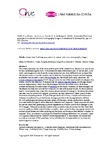Mostrar o rexistro simple do ítem
Intraretinal fluid map generation in optical coherence tomography images
| dc.contributor.author | Vidal, Plácido | |
| dc.contributor.author | Moura, Joaquim de | |
| dc.contributor.author | Novo Buján, Jorge | |
| dc.contributor.author | Penedo, Manuel | |
| dc.contributor.author | Ortega Hortas, Marcos | |
| dc.date.accessioned | 2023-12-18T16:16:09Z | |
| dc.date.issued | 2020 | |
| dc.identifier.citation | Vidal, P. L., Moura, J. de, Novo, J., Penedo, M. G., & Ortega, M. (2020). Intraretinal fluid map generation in optical coherence tomography images. In Diabetes and Retinopathy (pp. 19–43). Elsevier. doi: 10.1016/B978-0-12-817438-8.00002-X | es_ES |
| dc.identifier.isbn | 978-0-12-817438-8 | |
| dc.identifier.uri | http://hdl.handle.net/2183/34541 | |
| dc.description.abstract | [Abstract]: The retina represents one of the most studied parts of the human body, thanks to its easy access for any ophthalmological study. It represents the main neurosensory part of the eye and, by its study, pathologies not only from the visual system but also from different body systems (like the neural system or vascular system) can be detected. Among the principal medical imaging modalities that are used to study the eye fundus and the retinal histological structures, the optical coherence tomography (OCT) has proven to be one of the most reliable techniques. It is widely used for the detection of diseases like the diabetic macular edema and the age-related macular degeneration, which cause fluid leakages between the retinal layers. Both these diseases are among the main causes of blindness in developed countries, as these leakages tear the retinal structure and provoke the formation of other pathological bodies. As the symptoms start to be noticeable only when they cause a severe amount of damage to the retinal structures that may only be solved with surgical procedures, an early detection of these cystoid bodies became an impending matter. If these leakages are found in time, a simple and noninvasive treatment is sufficient to prevent further damage and reduce the damage already suffered. As both pathologies are among the main causes of blindness, several studies have recently proposed methodologies to aid in their early detection and diagnosis. These proposals all circle around the same idea: generating a precise segmentation of these cystoid fluid leakages in the OCT images. These proposals have achieved an acceptable rate of success, but they limit their scope to perfectly define cystoid bodies. In reality, these cystoid bodies may appear mixed with normal retinal tissues and other pathological structures, not having a clear defined boundary to segment. Thus, an alternative paradigm for these fluid leakage detections was proposed, based on a regional analysis and an intuitive robust representation. In this chapter, we explain and provide an overview of this paradigm, and possibilities for its implementation in computer-aided diagnostic systems. | es_ES |
| dc.description.sponsorship | This study was supported by the Instituto de Salud Carlos III, Government of Spain and FEDER funds of the European Union through the DTS15/00153 research projects and by the Ministerio de Economía y Competitividad, Government of Spain through the DPI2015-69948-R research project. Also, this study has received financial support from the European Union (European Regional Development Fund [ERDF]) and the Xunta de Galicia, Centro singular de investigación de Galicia accreditation 2016–19, Ref. ED431G/01; and Grupos de Referencia Competitiva, Ref. ED431C 2016-047. | es_ES |
| dc.description.sponsorship | Xunta de Galicia; ED431G/01 | es_ES |
| dc.description.sponsorship | Xunta de Galicia; ED431C 2016-047 | es_ES |
| dc.language.iso | eng | es_ES |
| dc.publisher | Elsevier | es_ES |
| dc.relation | info:eu-repo/grantAgreement/MINECO/Plan Estatal de Investigación Científica y Técnica y de Innovación 2013-2016/DTS15%2F00153/ES/SIRIUS - Sistema de análisis de microcirculación retiniana: evaluación multidisciplinar e integración en protocolos clínicos | es_ES |
| dc.relation | info:eu-repo/grantAgreement/MINECO/Plan Estatal de Investigación Científica y Técnica y de Innovación 2013-2016/DPI2015-69948-R/ES/IDENTIFICACION Y CARACTERIZACION DEL EDEMA MACULAR DIABETICO MEDIANTE ANALISIS AUTOMATICO DE TOMOGRAFIAS DE COHERENCIA OPTICA Y TECNICAS DE APRENDIZAJE MAQUINA | es_ES |
| dc.relation.uri | https://doi.org/10.1016/B978-0-12-817438-8.00002-X | es_ES |
| dc.rights | Copyright © 2020 Elsevier Inc. All rights reserved. | es_ES |
| dc.subject | Optical coherence tomography | es_ES |
| dc.subject | Computer-aided diagnosis | es_ES |
| dc.subject | Intraretinal fluid accumulations | es_ES |
| dc.subject | Binary map | es_ES |
| dc.subject | Confidence map | es_ES |
| dc.subject | Image sampling | es_ES |
| dc.subject | Classification | es_ES |
| dc.subject | Voting strategy | es_ES |
| dc.title | Intraretinal fluid map generation in optical coherence tomography images | es_ES |
| dc.type | info:eu-repo/semantics/bookPart | es_ES |
| dc.rights.access | info:eu-repo/semantics/embargoedAccess | es_ES |
| dc.date.embargoEndDate | 9999-99-99 | es_ES |
| dc.date.embargoLift | 10007-06-07 | |
| dc.identifier.doi | https://doi.org/10.1016/B978-0-12-817438-8.00002-X |






